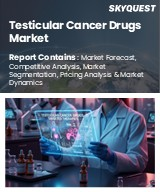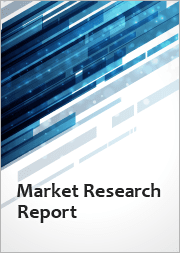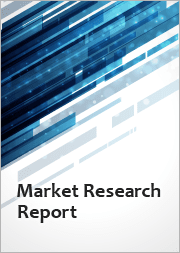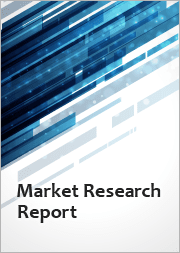
|
시장보고서
상품코드
1687502
암 치료제 시장 규모, 점유율, 성장 분석 : 치료 유형별, 약제 클래스별, 투여 경로별, 암 유형별, 최종사용자별, 유통 채널별, 지역별 - 산업 예측(2025-2032년)Cancer Therapeutics Market Size, Share, and Growth Analysis, By Therapy Type, By Drug Class, By Route of Administration, By Cancer Type, By End User, By Distribution Channel, By Region - Industry Forecast 2025-2032 |
||||||
암 치료제 시장 규모는 2023년에 2,106억 9,000만 달러로 평가되며, 2024년 2,315억 5,000만 달러에서 2032년에는 4,927억 5,000만 달러로 성장하며, 예측 기간(2025-2032년) CAGR은 9.9%로 성장할 전망입니다.
암 치료제 산업은 전 세계에서 암 발병률이 증가함에 따라 큰 성장을 이룰 것으로 예상됩니다. 종양학 연구에 대한 투자 증가와 첨단 치료 옵션에 대한 수요 증가는 이 분야의 기업에게 유망한 기회를 제공합니다. 또한 유전자 치료와 다양한 암종에 대한 맞춤 치료의 채택이 확대되고 있는 것도 이 시장을 촉진하고 있습니다. 또한 병용요법의 부상과 종양학 연구에 대한 정부 보조금 증가는 향후 수년간 매출을 증가시킬 것으로 예상됩니다. 그러나 약제 내성, 암의 불균일성, 치료로 인한 잠재적 부작용과 같은 문제는 진화하는 상황에서 여전히 의료 서비스 프로바이더에게 중요한 관심사입니다.
목차
서론
- 조사의 목적
- 조사 범위
- 정의
조사 방법
- 정보 조달
- 2차와 1차 데이터 방법
- 시장 규모 예측
- 시장의 전제조건과 제한
개요
- 세계 시장 전망
- 공급과 수요 동향 분석
- 부문별 기회 분석
시장 역학과 전망
- 시장 개요
- 시장 규모
- 시장 역학
- 촉진요인과 기회
- 억제요인과 과제
- Porter의 산업 분석
주요 시장 인사이트
- 주요 성공 요인
- 경쟁의 정도
- 주요 투자 기회
- 시장 에코시스템
- 시장의 매력 지수(2024년)
- PESTEL 분석
- 거시경제 지표
- 밸류체인 분석
- 가격 분석
- 사례 연구
- 규제 상황
암 치료제 시장 규모 : 치료 유형별 & CAGR(2025-2032)
- 시장 개요
- 화학요법
- 면역치료
- 표적치료
- 호르몬 요법
- 방사선 치료
- 줄기세포 이식
- 유전자 치료
- 기타 새로운 치료 유형
암 치료제 시장 규모 : 약제 클래스별 & CAGR(2025-2032)
- 시장 개요
- 알킬화제
- 대사 길항 물질
- 항종양 항생제
- 토포이소머라아제 저해제
- 유사분열 저해제
- 호르몬 요법
- 면역 체크포인트 저해제
- 기타
암 치료제 시장 규모 : 투여 경로별 & CAGR(2025-2032)
- 시장 개요
- 경구
- 정맥내
- 피하
- 근육내
- 국소
- 기타
암 치료제 시장 규모 : 암 유형별 & CAGR(2025-2032)
- 시장 개요
- 폐암
- 유방암
- 전립선암
- 대장암
- 피부암
- 혈액암(백혈병 림프종 등)
- 소화기암
- 부인과 암
- 호흡기/폐암
- 기타 암 유형
암 치료제 시장 규모 : 최종사용자별 & CAGR(2025-2032)
- 시장 개요
- 병원
- 전문 클리닉
- 암·방사선 치료 센터
암 치료제 시장 규모 : 유통 채널별 & CAGR(2025-2032)
- 시장 개요
- 병원 약국
- 소매 약국
- 온라인 약국
암 치료제 시장 규모 : 지역별 & CAGR(2025-2032)
- 북미
- 미국
- 캐나다
- 유럽
- 독일
- 스페인
- 프랑스
- 영국
- 이탈리아
- 기타 유럽 지역
- 아시아태평양
- 중국
- 인도
- 일본
- 한국
- 기타 아시아태평양
- 라틴아메리카
- 브라질
- 기타 라틴아메리카 지역
- 중동 및 아프리카
- GCC 국가
- 남아프리카공화국
- 기타 중동 및 아프리카
경쟁 정보
- 상위 5사의 비교
- 주요 기업의 시장 포지셔닝(2024년)
- 주요 시장 기업이 채택한 전략
- 최근 시장 동향
- 기업의 시장 점유율 분석(2024년)
- 주요 기업의 기업 개요
- 기업의 상세
- 제품 포트폴리오 분석
- 기업의 부문별 점유율 분석
- 매출의 전년대비 비교(2022-2024)
주요 기업 개요
- Bristol-Myers Squibb(USA)
- Merck & Co.(USA)
- Roche(Switzerland)
- Pfizer(USA)
- Novartis(Switzerland)
- Johnson & Johnson(USA)
- AstraZeneca(UK)
- GlaxoSmithKline(UK)
- Amgen(USA)
- AbbVie(USA)
- Sanofi(France)
- Bayer(Germany)
- Eli Lilly(USA)
- Takeda Pharmaceutical(Japan)
- Astellas Pharma(Japan)
- Gilead Sciences(USA)
- Celgene(USA)
- Daiichi Sankyo(Japan)
- Biogen(USA)
- Dr. Reddy's Laboratories(India)
결론과 제안
KSA 25.04.23Cancer Therapeutics Market size was valued at USD 210.69 billion in 2023 and is poised to grow from USD 231.55 billion in 2024 to USD 492.75 billion by 2032, growing at a CAGR of 9.9% during the forecast period (2025-2032).
The cancer therapeutics industry is poised for significant growth as the global prevalence of cancer continues to rise. Increased investments in oncology research and an escalating demand for advanced treatment options are creating promising opportunities for companies in this sector. The market is further enhanced by the escalating adoption of gene therapies and personalized medicine tailored for various cancer types. Additionally, the rise of combination therapies and heightened government funding for oncology research are expected to drive sales in the coming years. However, challenges such as drug resistance, the heterogeneity of cancer, and potential adverse effects of treatments remain critical concerns for providers in this evolving landscape.
Top-down and bottom-up approaches were used to estimate and validate the size of the Cancer Therapeutics market and to estimate the size of various other dependent submarkets. The research methodology used to estimate the market size includes the following details: The key players in the market were identified through secondary research, and their market shares in the respective regions were determined through primary and secondary research. This entire procedure includes the study of the annual and financial reports of the top market players and extensive interviews for key insights from industry leaders such as CEOs, VPs, directors, and marketing executives. All percentage shares split, and breakdowns were determined using secondary sources and verified through Primary sources. All possible parameters that affect the markets covered in this research study have been accounted for, viewed in extensive detail, verified through primary research, and analyzed to get the final quantitative and qualitative data.
Cancer Therapeutics Market Segments Analysis
Global Cancer Therapeutics Market is segmented by Therapy Type, Drug Class, Route of Administration, Cancer Type, End User, Distribution Channel and region. Based on Therapy Type, the market is segmented into Chemotherapy, Immunotherapy, Targeted Therapy, Hormonal Therapy, Radiation Therapy, Stem Cell Transplant, Gene Therapy and Other Emerging Therapies. Based on Drug Class, the market is segmented into Alkylating Agents, Antimetabolites, Antitumor Antibiotics, Topoisomerase Inhibitors, Mitotic Inhibitors, Hormone Therapies, Immune Checkpoint Inhibitors and Others. Based on Route of Administration, the market is segmented into Oral, Intravenous, Subcutaneous, Intramuscular, Topical and Others. Based on Cancer Type, the market is segmented into Lung Cancer, Breast Cancer, Prostate Cancer, Colorectal Cancer, Skin Cancer, Blood Cancer (Leukemia, Lymphoma, etc.), Gastrointestinal Cancer, Gynecologic Cancer, Respiratory/Lung Cancer and Other Cancer Types. Based on End User, the market is segmented into Hospitals, Specialty Clinics and Cancer and Radiation Therapy Centers. Based on Distribution Channel, the market is segmented into Hospital Pharmacies, Retail Pharmacies and Online Pharmacies. Based on region, the market is segmented into North America, Europe, Asia Pacific, Latin America and Middle East & Africa.
Driver of the Cancer Therapeutics Market
The rise in cancer cases globally can be largely attributed to poor lifestyle choices and the increasing prevalence of unhealthy habits among individuals. This alarming trend has contributed to a substantial increase in the number of individuals diagnosed with cancer, thereby driving the demand for cancer therapeutics. As more people require effective treatments to combat this disease, the cancer therapeutics market is experiencing notable growth. The urgent need for innovative therapies to address the escalating cancer burden is highlighting the importance of investment and research in this market, further fueling its expansion in response to the growing health crisis.
Restraints in the Cancer Therapeutics Market
The rapid evolution of cancer cells and tumors has led to increasing resistance to various treatment modalities, significantly impacting the sales of cancer therapeutics. This resistance not only hampers the effectiveness of existing drugs but also poses a considerable challenge for the entire cancer therapeutics market, ultimately hindering its growth. As therapies become less effective against resistant tumors, the demand for innovative treatments rises, yet the slow pace of drug development and approval can exacerbate market stagnation. Consequently, the challenges posed by evolving cancer biology and drug resistance serve as a significant restraint on the progress of the cancer therapeutics market.
Market Trends of the Cancer Therapeutics Market
The Cancer Therapeutics market is witnessing a significant trend towards the integration of artificial intelligence (AI) in drug discovery and development processes. Companies are increasingly leveraging AI technologies to streamline research initiatives, identify novel drug targets, and enhance the efficacy of existing treatments. This trend not only accelerates innovation but also reduces time-to-market for new therapies. Additionally, AI is poised to play a broader role across various facets of the cancer therapeutics landscape, including personalized medicine and patient management, thereby driving efficiency and improving clinical outcomes. As this trend matures, it is expected to reshape the competitive dynamics of the market significantly.
Table of Contents
Introduction
- Objectives of the Study
- Scope of the Report
- Definitions
Research Methodology
- Information Procurement
- Secondary & Primary Data Methods
- Market Size Estimation
- Market Assumptions & Limitations
Executive Summary
- Global Market Outlook
- Supply & Demand Trend Analysis
- Segmental Opportunity Analysis
Market Dynamics & Outlook
- Market Overview
- Market Size
- Market Dynamics
- Drivers & Opportunities
- Restraints & Challenges
- Porters Analysis
- Competitive rivalry
- Threat of substitute
- Bargaining power of buyers
- Threat of new entrants
- Bargaining power of suppliers
Key Market Insights
- Key Success Factors
- Degree of Competition
- Top Investment Pockets
- Market Ecosystem
- Market Attractiveness Index, 2024
- PESTEL Analysis
- Macro-Economic Indicators
- Value Chain Analysis
- Pricing Analysis
- Case Studies
- Regulatory Landscape
Global Cancer Therapeutics Market Size by Therapy Type & CAGR (2025-2032)
- Market Overview
- Chemotherapy
- Immunotherapy
- Targeted Therapy
- Hormonal Therapy
- Radiation Therapy
- Stem Cell Transplant
- Gene Therapy
- Other Emerging Therapies
Global Cancer Therapeutics Market Size by Drug Class & CAGR (2025-2032)
- Market Overview
- Alkylating Agents
- Antimetabolites
- Antitumor Antibiotics
- Topoisomerase Inhibitors
- Mitotic Inhibitors
- Hormone Therapies
- Immune Checkpoint Inhibitors
- Others
Global Cancer Therapeutics Market Size by Route of Administration & CAGR (2025-2032)
- Market Overview
- Oral
- Intravenous
- Subcutaneous
- Intramuscular
- Topical
- Others
Global Cancer Therapeutics Market Size by Cancer Type & CAGR (2025-2032)
- Market Overview
- Lung Cancer
- Breast Cancer
- Prostate Cancer
- Colorectal Cancer
- Skin Cancer
- Blood Cancer (Leukemia, Lymphoma, etc.)
- Gastrointestinal Cancer
- Gynecologic Cancer
- Respiratory/Lung Cancer
- Other Cancer Types
Global Cancer Therapeutics Market Size by End User & CAGR (2025-2032)
- Market Overview
- Hospitals
- Specialty Clinics
- Cancer and Radiation Therapy Centers
Global Cancer Therapeutics Market Size by Distribution Channel & CAGR (2025-2032)
- Market Overview
- Hospital Pharmacies
- Retail Pharmacies
- Online Pharmacies
Global Cancer Therapeutics Market Size & CAGR (2025-2032)
- North America (Therapy Type, Drug Class, Route of Administration, Cancer Type, End User, Distribution Channel)
- US
- Canada
- Europe (Therapy Type, Drug Class, Route of Administration, Cancer Type, End User, Distribution Channel)
- Germany
- Spain
- France
- UK
- Italy
- Rest of Europe
- Asia Pacific (Therapy Type, Drug Class, Route of Administration, Cancer Type, End User, Distribution Channel)
- China
- India
- Japan
- South Korea
- Rest of Asia-Pacific
- Latin America (Therapy Type, Drug Class, Route of Administration, Cancer Type, End User, Distribution Channel)
- Brazil
- Rest of Latin America
- Middle East & Africa (Therapy Type, Drug Class, Route of Administration, Cancer Type, End User, Distribution Channel)
- GCC Countries
- South Africa
- Rest of Middle East & Africa
Competitive Intelligence
- Top 5 Player Comparison
- Market Positioning of Key Players, 2024
- Strategies Adopted by Key Market Players
- Recent Developments in the Market
- Company Market Share Analysis, 2024
- Company Profiles of All Key Players
- Company Details
- Product Portfolio Analysis
- Company's Segmental Share Analysis
- Revenue Y-O-Y Comparison (2022-2024)
Key Company Profiles
- Bristol-Myers Squibb (USA)
- Company Overview
- Business Segment Overview
- Financial Updates
- Key Developments
- Merck & Co. (USA)
- Company Overview
- Business Segment Overview
- Financial Updates
- Key Developments
- Roche (Switzerland)
- Company Overview
- Business Segment Overview
- Financial Updates
- Key Developments
- Pfizer (USA)
- Company Overview
- Business Segment Overview
- Financial Updates
- Key Developments
- Novartis (Switzerland)
- Company Overview
- Business Segment Overview
- Financial Updates
- Key Developments
- Johnson & Johnson (USA)
- Company Overview
- Business Segment Overview
- Financial Updates
- Key Developments
- AstraZeneca (UK)
- Company Overview
- Business Segment Overview
- Financial Updates
- Key Developments
- GlaxoSmithKline (UK)
- Company Overview
- Business Segment Overview
- Financial Updates
- Key Developments
- Amgen (USA)
- Company Overview
- Business Segment Overview
- Financial Updates
- Key Developments
- AbbVie (USA)
- Company Overview
- Business Segment Overview
- Financial Updates
- Key Developments
- Sanofi (France)
- Company Overview
- Business Segment Overview
- Financial Updates
- Key Developments
- Bayer (Germany)
- Company Overview
- Business Segment Overview
- Financial Updates
- Key Developments
- Eli Lilly (USA)
- Company Overview
- Business Segment Overview
- Financial Updates
- Key Developments
- Takeda Pharmaceutical (Japan)
- Company Overview
- Business Segment Overview
- Financial Updates
- Key Developments
- Astellas Pharma (Japan)
- Company Overview
- Business Segment Overview
- Financial Updates
- Key Developments
- Gilead Sciences (USA)
- Company Overview
- Business Segment Overview
- Financial Updates
- Key Developments
- Celgene (USA)
- Company Overview
- Business Segment Overview
- Financial Updates
- Key Developments
- Daiichi Sankyo (Japan)
- Company Overview
- Business Segment Overview
- Financial Updates
- Key Developments
- Biogen (USA)
- Company Overview
- Business Segment Overview
- Financial Updates
- Key Developments
- Dr. Reddy's Laboratories (India)
- Company Overview
- Business Segment Overview
- Financial Updates
- Key Developments






